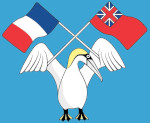Brief Histories Of Paimpol & Dartmouth
Dartmouth
Before 1066 no town existed on the site of modern Dartmouth, only the small village of Townstal at the top of the hill. After the Normans arrived, they soon realised the value of this safe harbour for cross-Channel voyages, and by the l2th century it had become a port well enough known for supplying ships to become the assembly point for the European fleet setting off for both the 2nd and 3rd Crusades.
The town was granted a royal charter in 1341, and in 1372 a fort at the mouth of the river was built to defend the town from attacks from across the Channel during the wars with France. A moveable chain could be slung between the castles at the river entrance to prevent attacks and the fort was one of the first in the country to use gunpowder artillery. In 1404 at the Battle of Slapton Sands, an army of untrained locals defeated the well-armed knights of the 2000-strong Breton force that landed at Slapton. In 1588, when Dartmouth was under threat from the Spanish Armada, the town sent eleven ships to join the English fleet and captured the Spanish flagship that was anchored in the Dart.
By the 14th century the town’s merchants were growing rich through the Bordeaux wine trade. Another reason for the growing prosperity of the town was the rich fishing from the Newfoundland cod banks, the results of this prosperous trading are seen today in the 17th century Butterwalk, Quay and many 18th century houses around the town. Locally made goods were traded with Newfoundland by the 18th century and much of the salted cod was sold to Spain and Portugal in exchange for wine and port, and some present day Dartmouth families still have connections with the Portuguese wine trade.
In the mid 19th century the town faced a serious economic crisis when the Newfoundland trade collapsed, but it gradually recovered in the second half of the 19th century. Dartmouth’s importance as a naval port declined as Plymouth’s grew, but in 1863 the Royal Navy stationed two training ships in the river, later replacing them with the naval college in 1905, and in 1864 the railway arrived in Kingswear, both these events helping to raise the town’s economic prospects. Today most of the local economy is based on the leisure and tourist industries.
Paimpol
One of the earliest references to Paimpol dates back to the 12th century. The name “Paimpol” comes from the Breton language “pen” (extremity) and “poull” (lake).
In the 16th century, Paimpol belonged to the Count of Vertus. For some years from 1591, the French king, Henri IV, was facing the forces of the Catholic League of Brittany (the Leaguers). The king was forced to request the help of the British Queen Elizabeth I, who sent a force of 2,400 soldiers under the command Sir John Norris who were garrisoned in Paimpol. In 1593, the bandit Guy Eder de la Fontelle, who supported the Leaguers, entered Paimpol, now undefended after the departure of the English, to pillage and burn the town and massacre a large number of its inhabitants.
Gradually the town developed due to its port which was the main base for Breton privateers and the trading of cider, salt and oil with England. Later, and above all, Paimpol became one of the home ports for the fishing fleets that fished the Icelandic waters in the second half of the 19th and the beginning of the 20th century. In 1886 the French novelist, Pierre Loti, wrote his book “Pêcheur d’Islande” (An Icelandic Fisherman) based on this period of Paimpol’s history.
Thanks to Portuguese trading at the beginning of the 15th century, Europe discovered a new fish – the cod! The subsequent growth in the popularity of this new found fish led to a big expansion of the offshore fishing fleets. In France, the Breton sailors from Paimpol and St. Malo, the Norman sailors from Barfleur and Dieppe, and others from La Rochelle and the Basque Country set out to fish for cod in the waters of the Canadian Grand Banks and the Gulf of St. Lawrence, even before the discovery of America by Christopher Columbus: the charter of Beauport indicated that the people from the nearby Île de Bréhat knew of Newfoundland from 1456! All these adventurous crews found themselves in the open waters off Newfoundland in company with Portuguese, Irish, English, Venetian and Dutch fishermen.
In 1852, Paimpol’s fishermen turned their attention to fishing in the open waters around Iceland. By 1856 Iceland became the preferred destination because it was more profitable. 1895 saw the peak in the number of fishing boats going to Iceland. After this, Paimpol saw a decline in its fishing fleet, with many boats destroyed after the First World War, until in 1935, when the last Paimpolais goëlette (schooner), “La Glycine” set sail on its last fishing expedition to Iceland.
